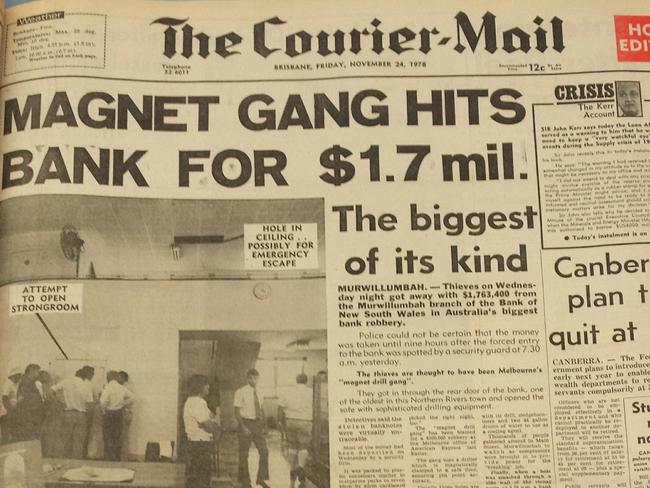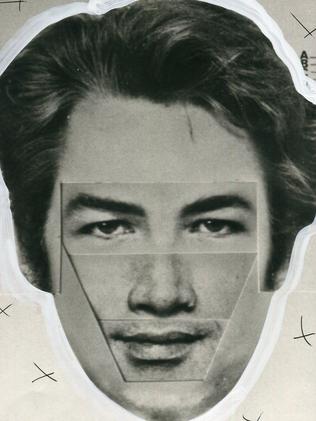
IT was an unlikely setting for Australia’s biggest bank heist.
On a muggy November night in the sleepy sugar cane town of Murwillumbah, just across the NSW border from the Gold Coast, a gang of five highly-skilled, professional bank robbers pulled off an audacious crime.
Their target was the Bank of NSW (now Westpac), on the town’s main street, just a few steps from the police station.
As the town slept, the men broke into the bank through the wooden back door, and made straight for the strongroom.
There, they set up a sophisticated magnetic drilling rig and proceeded to bust open the vault.
Inside was $1,763,400 in used bills - 50s, 20s, 10s, fives, twos and ones - neatly packed into small plastic containers inside seven cardboard boxes.
That’s about $8.3 million in today’s money.
When they had completed their haul, the gang calmly removed the loot and packed away their equipment, before removing the dials and the handle to the Chubb safe which had contained the notes.
On their way out, they jammed the tumblers to the locks on the strongroom.

At 7.30am on Thursday, November 23, 1978, a security guard doing his rounds noticed something amiss at the rear of the bank.
The wooden doors were slightly ajar. Of the two locks, one was broken. Within minutes, the police had arrived. What they found inside staggered them.
The strongroom had been tampered with, but they couldn’t know for sure because they couldn’t get in. With the tumblers on the lock jammed, the police and bank staff were helpless.
Four safe installation experts from Chubb were flown down from Brisbane in a hastily-organised charter flight. Despite their best efforts, they couldn’t get in either.
A council work crew with drills, jackhammers and other machinery who were working nearby were then called in to smash through the bank’s outside wall and into the vault.
By that time, hundreds of people had crowded the town’s main street to watch the drama unfold.
At around 4.30pm, nine hours after the security guard raised the alarm, the workers broke through.
A bank official stuck his head through and confirmed what everyone had suspected: The cupboard was bare.
It was Australia’s biggest heist since the audacious Great Bookie Robbery, when machine gun-toting crooks stole $1.3 million as bookmakers paid out bets at Melbourne’s Victorian Club in April 1976. And it has never been solved.

The culprits were sophisticated in their methods. They used an electro-magnetic drill stand that clamped onto the safe and allowed them to drill to within 5mm of the crucial point in the locking system.
The stand gave them the power they needed to drill through heavy vaults. They used an ordinary two-speed drill to get into the locking mechanism so they could manipulate the tumblers. The entire process probably took several hours, police said at the time.
They needed to be precise. If they had been just a fraction of a millimetre either way when drilling above the tumblers it would have ruined the whole operation.
The gang used an expensive medical cystoscope to look through the holes they drilled and a wire attachment to operate the tumblers inside.

“They were neat, expert, professional,” a detective told reporters.
Police at the time said it was a unique method of busting into a safe, perfected after a safe door was stolen from a Melbourne store in 1976.
The gang had already been blamed for a string of robberies in Melbourne before the Murwillumbah job, including the theft of $350,000 in cash from an American Express office and $250,000 of diamonds, gold, and jewellery from a jewellers. Both businesses used Chubb safes similar to the one in Murwillumbah.
Why did a regional bank have so much cash? Townsfolk said it was an open secret that the Bank of NSW in Murwillumbah held massive sums of money every second Wednesday. The branch held cash for public servants’ paypackets and was used as a holding bank for money around the district because its strongroom was considered the safest.
Every fortnight, an armoured van, usually accompanied by five armed guards, would pull up at the bank to unload bundles of cash.
Any would-be thieves would have no trouble casing the place - the bank was opposite The Imperial Hotel and the van sometimes stopped traffic in the town’s main street. A crook could enjoy a beer while scoping out the drop.
One local told The Courier-Mail: “It was a very well-known sight.”
On day two of the investigation, Detective Sergeant Don Jones, of Murwillumbah CIB, said there was a possibility that someone associated with the bank or the cash-courier service, Transurety Australia, had leaked information to the thieves.
“We are looking at all the possibilities”, Detective Jones said. “The thieves certainly knew the layout of the bank and it was a very professional operation”.

Despite the gang making a slick getaway, there were initially some solid leads. Two girls reported seeing three men acting suspiciously outside the bank around 10.30pm on the night of the crime. One of the men, they said, was extremely short.
A radio station announcer, Kim Fisher, said he heard banging in Main Street about 1.30am, as he knocked off work. Another man saw a white panel van parked behind the bank around 9.45pm and watched a man “acting suspiciously” - loitering around the car, kicking the tyres and opening the bonnet.
The witness said the man looked as if he was casing the bank. “he was there about five minutes, then drove away,” he told The Sunday Mail.
Identikits were circulated. One of the robbers was described as short, solidly built, with dark hair, wearing flares and a red shirt.
The gang had probably driven down to Murwillumbah for the robbery then driven back up to Surfers Paradise.


“They were probably back in bed asleep before the robbery was discovered,” one detective said.
A team of 28 detectives interviewed bank staff and employees of Transurety and carried out a door-to-door canvass of the area around the bank in the days following the robbery.
Other teams of detectives checked information from the public, contacting motels, camping grounds, airlines and railways to see if anyone has noticed any suspicious behaviour in the days leading up to the heist. There was speculation the planning had gone on for months.
Police also “tore apart” the Gold Coast in the days after the robbery, hunting for leads.
But as one officer told media: “in an area with such a high holiday population in summer, we are finding this frustrating work”
There were no arrests and - despite a $250,000 reward - the investigation slowly wound down.
About 12 months later, some of the notes apparently turned up in Hong Kong. The trail then went cold.

Murwillumbah became famous as a result of the robbery, and locals were not slow to capitalise on the exposure.
Bush balladeers Bullamakanka wrote a song, and a local menswear shop marketed special T-shirts to mark the event. Tea towels, calendars, beer mugs and coffee cups followed, all recalling the night the Magnetic Drill Gang came to town, and put Murwillumbah on the map.
Tweed Shire identity and former mayor Max Boyd who was a councillor at the time, said townsfolk were shocked their sleepy town was the target of a professional heist.
“A robbery of that magnitude was something you’d only dream would happen in Murwillumbah,” he told The Tweed Daily News.
“It was certainly talked about frequently by people in town for years afterwards.”

Despite similar robberies elsewhere, little was heard of the gang until 1983.
On a quiet weekend in November that year, thieves laboriously cut through the reinforced-concrete roof of a Sydney bank to pull off a robbery which would eclipse the Murwillumbah job.
The scene was the elegant harbourside suburb of Rose Bay and the bank was a Westpac branch.
Missing were the contents of 40 safety deposit boxes belonging to some of Sydney’s richest people - gold and jewels worth at least $5 million.
Police were quick to blame the same gang who pulled off the Murwillumbah heist.
The gang took at least six hours to saw their way through a 40cm thick concrete floor into the bank vault.
The gang entered the two-storey brick building by climbing a rope they attached to a rear top floor toilet window.
“They then went downstairs, broke open the side door from the inside and hauled their gear up to an office directly above the vault,’ the detective said.
After lifting carpets and ripping up floor boards, the robbers used a large standard drill to lodge bolts in the floor to hold stabilising rods to keep the diamond-tipped drill-saw and its mounting in place. They then drilled a series of six 15cm holes.
A detective said: “The main operator used incredible expertise to cut the holes in two precise rows, effectively creating one large hole 45cm by 30cm to enable one gang member to drop into the vault and the rest to haul the boxes up into the office where they rifled them.’’
The burglary became known as the “Aladdin’s Cave’’ robbery.
It’s believed this was their last job.
* This story was previously published By News Corp Australia in March 2016.

The lie that cost underworld figure his life
When Carl Williams lied about Michael Marshall’s involvement in a contract killing, he as good as signed the hotdog salesman’s death warrant.
Lunchtime jewel heist which rocked Sydney’s CBD
In what was considered the biggest jewellery heist of the first half of the 20th century, in 1947 a thief managed to steal jewels worth about $600k today. But his glory was short-lived.